The Phunque Flask is the key element in a newly developed method for conducting specific gravity/absorption determinations for aggregate.
This method has been designed to eliminate the inherent guess work built into ASTM C128 and AASHTO T-84 — the current cone and tamper methods in use today. The test is easy to perform, easy to understand and easily reproducible between technicians and labs; and is very easy to run reliably in the field. The test can be especially helpful in asphalt operations where specific gravities can make a big impact on pay factors. This test lets the contractor check specific gravities on the material he is currently using, and not rely on lab tests, which may not be current.
The test provides repeatable and consistent test results despite the use of different labs or technicians. It also enables the contractor and DOTs to begin to come to terms with the inherent problem of how much the aggregate from a given pit or source varies, both by location within the pit, and from different fundamental geological characteristics.
Additionally, the test allows specific gravities to be tracked, and a moving-average chart maintained. If found to be appropriate, the contractor would be able to calculate the volumetrics using a moving average approach for the aggregate actually being used instead of the highly variable value determined in a lab 6 months to a year earlier. This process, itself, could eliminate many penalties and/or claims.
The HU-3388F is for fine aggregate and has a neck approximately 1" in diameter. The HU-3388L is used for coarse aggregate and has a neck approximately 2" in diameter. The scale on both items is readable to 0.1 grams; Both include an excel calculation sheet and a swabbing utensil to keep the neck of the flask dry during loading.
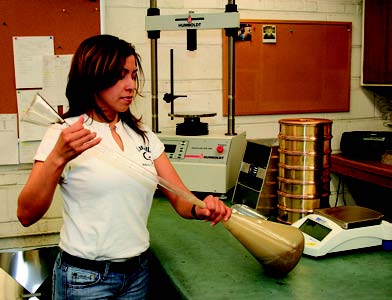
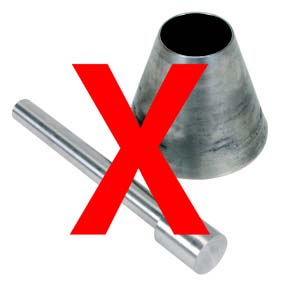
When performed correctly, the test for bulk specific gravity and absorption level for aggregate can give accurate, repeatable results with the Phunque Flask. By charting the results, technicians can track specific gravities and maintain a moving-average chart. In this way, a producer is able to calculate volumetrics using a moving average approach for the aggregate being used currently, rather than relying on values determined in the past. The producer will also have a repeatable test that any member of his team can learn to perform with accurate, useful results.
| THE PROCEDURE | |
| Step 1 | When using normal weight aggregate, weigh out 1200 +/- 10 grams of oven-dry sand or 5000 +/- 50 grams of coarse aggregate to be tested. Make sure that the sample accurately represents the material to be evaluated. If testing lightweight aggregate, reduce the amount of material weighed out to 600 +/- 10 grams. |
| Step 2 | Fill the flask approximately 1/2 full, by height, with distilled water. |
| Step 3 | Measure out, but do not add yet, approximately 250 g (8.82 ounces) of distilled water. |
| Note: The water will probably need to be adjusted for the individual flask being used. It is important that during the filling process, the combined initial volume of water and the dry soil do not plug the neck of the flask. Therefore, the following procedure is intended to allow sufficient water for the aggregate to become completely submerged, but to not rise into the narrow neck of the flask. Holdback water is then added to bring the initial water level after all of the aggregate and the holdback water has been added into the calibrated portion of the neck. | |
| Step 4 | Dry the neck of the flask with a dry, absorbent swab. |
| Note: If the neck is not completely dry, then the finer portions of the sample will get clogged up on the water droplets, and tend to plug the neck of the flask as the sample is being poured in. It is recommended that an outside funnel not be used. The sand has a tendency to plug the smaller hole of the funnel, where it typically pours through the built-in funnel without plugging. | |
| Step 5 | Pour the aggregate sample into the flask as quickly as possible, but without plugging the neck. |
| Step 6 | Start the timer immediately when the first "stone" hits the water in the flask. |
| Step 7 | After all of the sample has been poured into the flask, immediately pour in the holdback water measured out in Step 3 so that the final water level is sufficiently far up the calibrated neck to allow for accurate readings while the water level drops to its anticipated final level, being careful not to shake or agitate the flask and contents. |
| Step 8 | Take the initial reading 30 seconds after the first particle has entered the water. |
| Step 9 | Place the flask on a scale and obtain the total weight of the flask, aggregate and water. |
| Step 10 | Aggressively shake, roll and agitate the flask for a period of three minutes so that all of the air is allowed to escape. (A plug must be placed into the neck of the coarse aggregate flask to prevent loss of water during the shaking and agitation to prevent water loss during this step.) |
| Step 11 | Allow the flask to remain undisturbed for two minutes. |
| Step 12 | Obtain and record the reading at 5 minutes. |
| Step 13 | Repeat steps 9 through 11 to obtain additional readings at 10 minutes, 30 minutes, 60 minutes, 2 hours, 4 hours and 25 hours (plus or minus 1 hour),making sure to agitate all of the air out of the sample, as described in Step 10, and allowing the flask to settle for at least two minutes before taking each reading. |
| Note: Remember to eliminate all released air during the soak period from the flask before taking the final reading. Make sure that the flask has been completely shaken and agitated, and then allowed to rest undisturbed so all of the air has escaped. Take as much time as required to completely eliminate all of the air | |
| Step 14 | Add the base reading obtained from calibrating the flask to each of the individual readings. |
| Step 15 | Plot the readings on semi-log paper with the x-axis being "time" on the logarithmic scale. |
| Step 16 | Calculate absorption, conventional absorption, saturated bulk specific gravity (BSGssd) and dry bulk specific gravity (BSGd) with the equations detailed below. If necessary, apparent dry specific gravity (ASGd) can be calculated as well, but this is rarely used for construction aggregate applications. |
| Cat. No. | Description |
| HU-3383F | Specific Gravity Flask for Fine Aggregate |
| HU-3383L | Specific Gravity Flask for Large Aggregate |
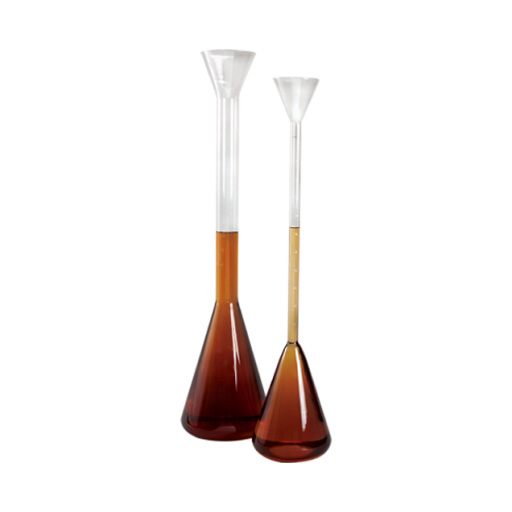
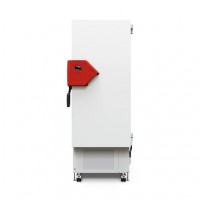
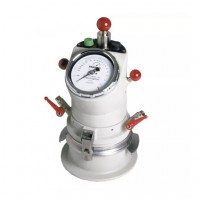
Do you have a question?
min 10 ch